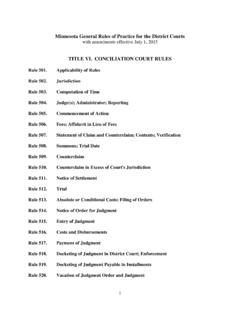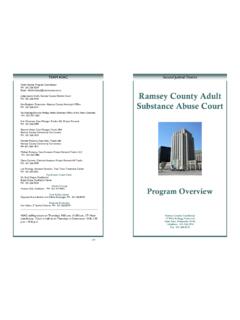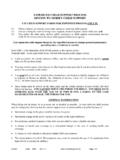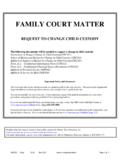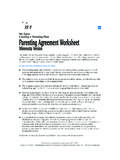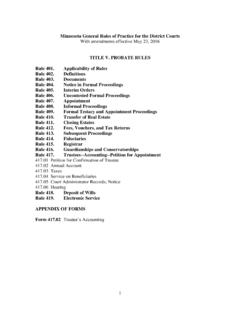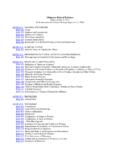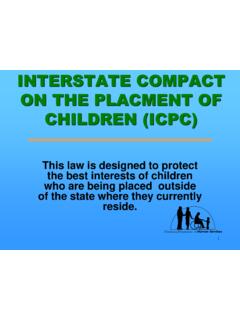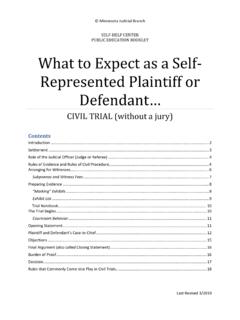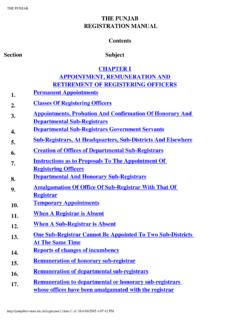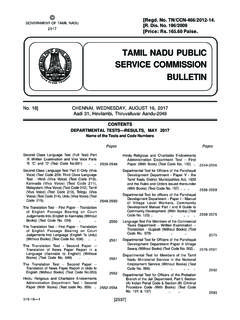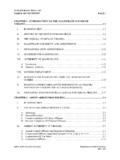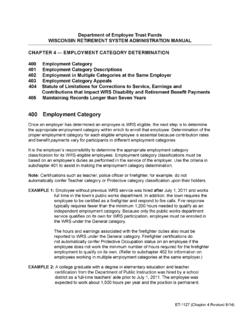Transcription of Guide for Handling OFPs and HROs - Minnesota
1 Minnesota Second Judicial district Juvenile and Family Division Guide for Handling : _____ ORDERS FOR PROTECTION AND HARASSMENT RESTRAINING ORDERS _____ Second Judicial district Family Violence Coordinating Council 2 Table of Contents I. Preface and Introduction A. Preface B. Introduction Orders for Protection II. Service and Cost A. Personal Service B. Service by Publication III. One Judge, One Family IV. Ex Parte Orders for Protection A. Jurisdictional Requirements B. Relationship C. Allegations of Domestic Abuse D. Ex Parte Options 1. Grant Ex Parte Order Without Hearing 2. Grant Ex Parte Order With Hearing Date a. court Grants Relief Requested b. court Declines to Order Some of the Relief Requested 3. Deny Ex Parte Order a. Issue Order for Hearing b. Grant Harassment Restraining Order E. Length of Time Ex Parte Order for Protection is Effective V. Relief A.
2 No Abuse B. No Contact C. Exclusion from Residence D. Exclusion from Employment E. Exclusion of Specific Distance Surrounding Residence F. Custody and Parenting Time 1. No Marriage, No Custody/Parenting Time Order 3 2. Prior Order Gives Joint Custody or Parties Are Married and No Order 3. Prior Order Gives Petitioner Sole Physical Custody 4. Prior Order Gives Respondent Sole Physical Custody 5. Petitioner Is Not Parent of Protected Child(ren) G. Protection of Pets or Companion Animals H. On Behalf Of (OBO) Minor Child(ren) 1. Caption of Case 2. Relief to Protect Child 3. Domestic Abuse Versus Reasonable Force to Restrain or Correct a Child 4. No Parental Access If No Adjudication of Parentage I. Continuation of Insurance Coverage VI. Additional Relief That Requires Hearing A. Child Support B. Spousal Maintenance C. Restitution D. Treatment or Counseling for Domestic Abuse and/or Chemical Dependency E.
3 Counseling or Other Social Services for the Parties F. Award Use and Possession of Property G. Firearms H. Duration of Order for Protection Following Hearing VII. Interface with Other court Actions A. Family court 1. Case Management Options in the Family Law Case 2. Different Legal Standards B. Juvenile court 1. Referral to Human Services 2. Custody C. Criminal court 1. Effect of Criminal and Civil Orders 2. Discovery When Criminal Proceedings Are Pending 3. Fifth Amendment Issues 4 VIII. Hearings A. Participants and Their Roles 1. district court Clerk 2. Advocates 3. Interpreters 4. Deputies 5. Guardians ad Litem B. Procedures 1. Mentally Ill Parties 2. Incompetent Parties 3. Discovery when Criminal Proceedings Are Pending 4. Administrative Continuances C. Initial Hearings 1. Parties' Appearance a. Both Parties Appear b. Service Not Completed, No Appearance by Respondent c.
4 Service Completed, No Appearance by Respondent d. No Appearance by Petitioner e. Neither Party Appears 2. Respondent s Options 3. Continuances a. By Request of the Parties 4. Interim Custody and Parenting Time D. Evidentiary Hearings 1. Introduction 2. Respondent's Options 3. Standard of Proof 4. Opening Statements 5. Continuances 6. Testimony a. Out-of- court Statements by Children b. In- court Statements by Children c. Fifth Amendment Issues 7. Witnesses 8. Rulings 5 9. Reciprocal Orders for Protection 10. Collateral Consequences E. Motion Hearings 1. Types of Motions a. Non-Emergency b. Emergency c. Motion for New Trial d. Motions to Dismiss e. Request for Immediate Dismissal F. Review Hearings G. Contempt Hearings IX. Subsequent Orders and Extensions A. Subsequent Orders B. Extensions of Existing Orders C. 50-Year Orders Harassment Restraining Orders X. Service and Cost A.
5 Service 1. Personal Service 2. Publication 3. Service Upon Juvenile Respondents B. Filing Fees and Cost of Service XI. One Judge, One Family XII. Ex Parte Harassment Restraining Orders A. Jurisdictional Requirements B. Allegations of Harassment C. Ex Parte Options 1. Grant Ex Parte Order Without Hearing 2. Grant Ex Parte Order With Hearing Date a. court Grants Relief Requested b. court Declines to Order Some of the Relief Requested 6 3. Deny Ex Parte Order a. Issue Order for Hearing D. Length of Time Ex Parte Harassment Restraining Order Is in Effect XIII. Relief A. No Harassment B. No Contact C. Exclusion from Residence D. Exclusion from Employment E. Exclusion of Specific Distance Surrounding Residence F. On Behalf of (OBO) Minor Children XIV. Hearings A. Participants and Their Roles 1. district court Clerk 2. Advocates 3. Interpreters 4. Deputies B. Procedures 1. Mentally Ill Parties 2.
6 Incompetent Parties 3. Administrative Continuances C. Initial Hearings 1. Mediation 2. Parties' Appearances (Mediation Unsuccessful) a. Both Parties Appear b. Service Not Completed, No Appearance by Respondent c. Service Completed, No Appearance by Respondent d. No Appearance by Petitioner e. Neither Party Appears 3. Respondent's Options 4. Continuances a. By Request of the Parties D. Evidentiary Hearings 1. Introduction 2. Respondent's Options 7 3. Standard of Proof 4. Opening Statements 5. Continuances 6. Testimony a. Out-of- court Statements by Children b. Fifth Amendment Issues 7. Witnesses 8. Rulings 9. Mutual Harassment Restraining Orders 10. Collateral Consequences E. Motion Hearings 1. Types of Motions a. Non-Emergency b. Emergency c. Motion for New Trial d. Motion to Dismiss e. Request for Immediate Dismissal f. Contempt Hearings XV. Extensions and 50-Year Harassment Restraining Orders A.
7 Extending a Harassment Restraining Order B. 50-Year Harassment Restraining Orders Appendix A: Domestic Violence Risk Assessment Bench Guide 8 I. PREFACE AND INTRODUCTION A. PREFACE The Second Judicial district Family Violence Coordinating Council was formed as an interdisciplinary working group, as were similar councils in every judicial district throughout the state, on recommendation of the Minnesota Conference on Family Violence and the Courts, held in November 1993. The Council has met regularly since that time to work on improving Ramsey County s Handling of domestic violence cases in all parts of the system. In 1997, the Minnesota Legislature passed into law Minn. Stat. , establishing Family Violence Coordinating Councils (FVCC). A judicial district may establish a Family Violence Coordinating Council for the purpose of promoting innovative efforts to deal with family violence issues.
8 A coordinating council shall establish and promote interdisciplinary programs and initiatives to coordinate public and private legal and social services and law enforcement, prosecutorial and judicial activities. The chief judge appoints the members of the FVCC with representatives from judges, court administrators, probation; domestic abuse advocates and social services; health care and mental health care providers; law enforcement and prosecutors; public defenders and legal aid; educators and child protection works; and public officials and other public organizations. Since 1997, the Second Judicial district Family Violence Coordinating Council (FVCC) has continued as an interdisciplinary working group pursuant to the statute. The original Guide for Handling Orders for Protection and Harassment Restraining Orders was prepared by the FVCC and working subcommittee with adoption by the bench on April 19, 2008.
9 The FVCC has been responsible to periodically update the Guidelines with a working subcommittee, approval by the FVCC, and subsequent approval by the bench. The Second Edition was approved by the bench on May 26, 2009. The Third Edition was approved by the bench on February 22, 2011. Through the years, the guidelines have served everyone working on domestic violence cases in Ramsey County as a tool for interdisciplinary training, assisting in identification of weaknesses in the system and ways to improve systemic Handling of domestic abuse, developing protocols when needed, and coordinating proceedings involving family violence issues in keeping with Minn. Stat. , Subd. 3. This Fourth Edition of the Guide for Handling Orders for Protection and Harassment Restraining Orders was drafted by a subcommittee and approved by the FVCC on October 8, 2013. The subcommittee consisted of the following members: Hon.
10 Robert Awsumb (Judge), Bree Adams Bill (St. Paul Intervention Project), Amanda Jameson ( court Administration), Danielle Kluz (Bridges to Safety), Ann Leppanen (Retired Referee), Karen Oleson (Tubman), Rebecca Rossow (Referee), Valerie Snyder (Southern Minnesota Regional Legal Services), James Street (Referee), and Nykee Younghans ( court Domestic Abuse/Harassment Office). Changes were reviewed and input was provided from all members of the FVCC. The Guide was reviewed by the Family and Juvenile court bench. The Second Judicial district court bench approved the Fourth Edition of Guide for Handling Orders for Protection and Harassment Restraining Orders on _____, 2013. The Fourth Edition incorporates statewide legislative, case law developments, and 9 local procedural changes for the Handling of Orders for Protection and Harassment Restraining Orders since 2010 including statutory changes that took effect August 1, 2012.
